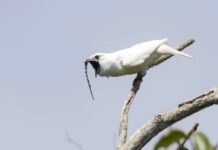Persea Americana is commonly called the avocado. Consumption of the ancient Mexican fruit dates back 10,000 years. The Aztecs called it ahuacatl, a name still used in some parts of Mexico.
Ahuacatl loosely translates to testicle, which makes sense as the Aztecs considered it an aphrodisiac and felt that eating it promoted fertility in both sexes. Also, avocados do have a bit of a sagging, ball-like shape.
Once discovered by Spanish conquistadors, the green fruit with the reptilian skin became a favorite. They shared it, introduced it to new arrivals, and, by 1521, had introduced it into Central Mexico and Colombia, at the crown of South America. The buttery, yummy Persea Americana was also brought back to the Old World, where European palates shared and celebrated it.
In the late 16th century, an English merchant named Hawkes traveled to the New World. In 1589, portions of his story were documented, including the observation that he used the word “alvacata” to identify the famous Mexican fruit. In 1696, the naturalist Sir Hans Sloane published a catalog of Jamaican plants that identified this particular fruit-bearing tree in his publication as: “The Avocado or Alligator-Pear Tree. It grows in gardens and fields throughout Jamaica.”
The Florida Keys have an interesting history with the avocado. In those days, the trees were referred to as alligator pears — a name based not on the origin story, but a reference to the color and texture of its skin. How does the alligator pear fit into Florida Keys’ history? Well, according to many stories about its history, including some earlier work I shared, Dr. Henry Perrine is credited with introducing the fruit to North America in the 1830s.
The story of Perrine and the alligator pear began in 1827 when he entered his 10-year post as a U.S. consul stationed on the Yucatan Peninsula. The primary responsibility of the medical doctor, who had a lifelong interest in the curative properties of botanicals, while he was stationed at Tabasco, Mexico, was checking cargo being imported from or exported to the United States. President John Quincy Adams sent a letter to each of the newly appointed consuls requesting they document any plants that might benefit the United States. Perrine was the one in 100 who took the directive seriously.
Not only did Perrine compile copious notes about the local flora, but he also noted seasonal weather patterns. He also shipped seeds and samples to horticulturally-minded friends in America, including the Florida Territory’s John Dubose and Charles Howe. Dubose, the lighthouse keeper at Key Biscayne’s Cape Florida Lighthouse, was sent more than 100 boxes of botanical samples.
As he had done with Dubose at Cape Florida, Perrine sent crates of botanicals to Charles Howe at Indian Key. He is credited with shipping some 72 species of plants to the United States. Two of the botanicals on that list are Citrus aurantiifolia, commonly called the Key lime, and Persea Americana, the avocado or alligator pear. Perhaps because of the copious notes about each plant he shipped, it has been assumed that he was the first to do it, as Perrine is often credited with introducing both species to American soil.
Last week, I was contacted by a writer in California working on a book about the history of the avocado. He asked about the credit often given to Perrine for introducing it to the U.S. in the 1830s. It did not take long to find documentation of the presence of avocados in Florida and the Keys predating Perrine’s time as a U.S. consul.
As has been the case with previous research, the observations of Dr. Benjamin Strobel proved illuminating. Strobel graduated from the Medical College of South Carolina in 1826.
Having heard that there was a need for medical professionals in Key West, he arrived on the island in the late summer days of 1828. Strobel’s voyage to the West Indies, to Key West, began on Sept. 5, 1828, when the doctor boarded the schooner Jane.
In addition to being a physician, Strobel was a writer who documented his trip from Charleston to Key West. When stopping at Indian Key, Strobel wrote about a dance party held on the island. Also, he remarked about several fruit trees and bushes growing on the island, including the lime, mulberry, lemons, papayas, flowering shrubs, and alligator pears. 1828 clearly predates the time when Perrine began sending botanical samples to the U.S.
And then there is an excerpt from the Account of East Florida, published by Dr. Stork, London, 1766, which definitively places Persea Americana in what is today the Sunshine State before Perrine was born. “The tenderest plants of the West Indies, such as the plantain, the alligator pear tree, the banana, the pine apple, or ananas, the sugar-cane & c. remain unhurt during the winter, in the gardens of St. Augustine.”
While the avocado was one of the 72 species of plants Perrine sent to the U.S. in the 1830s, he had not been the first to do so. Why, then, do so many sources attribute him as being the first? It is a classic parroting case that I have been guilty of in the past. A piece of information is shared over and over until it is presumed to be the truth. In the case of the avocado, or my preferred name for it, the alligator pear, the Spanish introduced it to the Old World, and, more than likely, the Spanish introduced it to what became American soil.
























